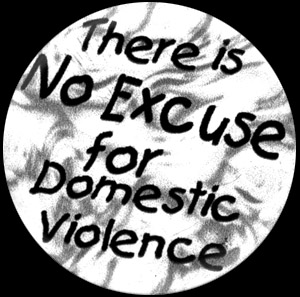
| HOME |
| NERVE |
| REVIEWS |
| ARCHIVE |
| EVENTS |
| LINKS |
| ABOUT US |
| CONTRIBUTORS |
| BACK ISSUES |
| CONTACT US |
Back to index of Nerve 19 - Winter 2011
Is Domestic Abuse at epidemic levels in the UK?
By Angela Clarke and Nina Doran
 On
average 2 women a week are killed by a male partner/former partner in
the United Kingdom(1), and one domestic
violence incident is reported to the police every minute of every day.(2)
Yet resources for women escaping a violent male are grossly underfunded
and under-imagined. Society has systematically failed to address domestic
abuse.
On
average 2 women a week are killed by a male partner/former partner in
the United Kingdom(1), and one domestic
violence incident is reported to the police every minute of every day.(2)
Yet resources for women escaping a violent male are grossly underfunded
and under-imagined. Society has systematically failed to address domestic
abuse.
This summer Judge James Allen QC got probation after a court rejected the claim that his wife punched herself in the face.(3) This judge would have probably got a tougher sentence if he had abused a stranger.
A report in February 2004 found that the police fail to record more than half of domestic violence crimes that are reported. Domestic violence cases are not being dealt with properly either by the probation services.
One local government report described reducing repeat victimisation as “the greatest challenge”. So why is domestic abuse so appallingly dealt with at all levels? Many would argue that it is obvious – that while society still has the worst excesses of gender inequality then consequences of that very inequality - domestic abuse - will remain its scourge/benefactor.
Domestic abuse is used to exert control within a relationship and "women are the overwhelming majority of the most heavily abused group”(4). Many women who suffer domestic abuse can suffer repeated abuse over years, with physical injuries ranging from cuts and bruises, broken limbs, miscarriages, and death. Abuse will usually result in emotional as well as physical effects as many women suffer from anxiety, depression, low self-esteem, and become isolated from friends and family.
Women and men in our society have unequal access to social and economic power. Community and societal ideas of what it means to be a man and to be a woman, contribute to the problem of violence, by supporting the traditional gendered power-imbalance. Attitudes and beliefs about gender are learned, and society often teaches deeply held sexist views(5). These dominant cultural ideas about gender are rarely explored and challenged.
All this makes it very difficult for a survivor to tell their story, and ignorance surrounding why VIOLENCE AGAINST WOMEN happens, means few women get supportive, appropriate responses, when they do tell. Well meaning responses, without a gendered analysis, can serve to support ideas of blame for the victim.
Liverpool has a high rate of reported incidents of domestic violence and abuse and high rates of multiple deprivation. In March 2011, research found that, “women are particularly affected by the economic downturn...”. This raises concerns, as there are strong links between domestic abuse and deprivation, in that financial dependency prevents women from leaving an abusive relationship.
The Government has pledged support in the ‘Violence against women and girls action plan 2011’. However, Liverpool is one of many cities that has experienced severe cuts in services and resources to support women and children who suffer abuse. At the less lethal levels, there are many examples of statutory services still holding women responsible for not leaving or controlling violent men, whilst not acting as a countervailing power.
Women’s specialist services are being decimated by the lack of adequate resourcing. One in five women’s services has closed down in the last three years.
- 46% had been forced to make staff redundancies or not renew contracts in the 12 months previous
- 29% were paying staff salaries out of their reserves
- 41% ended a project or closed a service in 2005/06 due to lack of funds (WRC, 2006).
Without urgent action we will see mass closures of more and more vital women’s services, resulting in women survivors not being able to access the crucial support they need and deserve to be able to move on from the impact of violence on their lives.(7)
 The Scottish
Government has shown its commitment to ending Violence Against Women.
In addition to funding of £10.5 million since 2000, the Scottish
Government has provided £3 million per annum in 2006/7 and 2007/08
through the Violence Against Women Fund, which has secured existing services
and expanded provision. In April 2008, further funding of £22 million
was announced in Scotland.
The Scottish
Government has shown its commitment to ending Violence Against Women.
In addition to funding of £10.5 million since 2000, the Scottish
Government has provided £3 million per annum in 2006/7 and 2007/08
through the Violence Against Women Fund, which has secured existing services
and expanded provision. In April 2008, further funding of £22 million
was announced in Scotland.
The importance of funding specialist domestic abuse work is not fully recognised, or echoed across nations and regions and this is a direct result of gender inequality. Also, while government policy has no gender focus, women will be at best misunderstood and at worst blamed for being victims of abuse. Women want to access women-only services; they find these services of immense value.
“It’s precisely because we don’t live in an equal society that it’s absolutely essential that there are specific services there for women. It’s a human rights issue.”(8)
Yet many local public sector bodies are getting this wrong, interpreting the gender equality duty in a gender-neutral way and challenging women’s services for not providing services to men, failing both women and their legal obligations under the gender equality duty.
Prevention is the key to ending violence against women. There needs to be a comprehensive public education campaign, across all forms of media and across a range of institutions, which does more than ‘Say No to Violence’- it must challenge the myths about why violence happens; challenge the social construction of masculinity and femininity; challenge the myths that blame women for violence and excuse perpetrators, and provide solid information for the public to use to support women who disclose experiences of violence.(9)
Men also have a role to play in stopping violence against women, by challenging other men’s sexist or violent behaviour. This is clearly not just ‘a women’s issue’. After all, protecting women is frequently the best form of child protection. The wealth of information about the huge extent and destructive impact of domestic abuse, human rights legislation and international obligations, the government has enough reason to make domestic abuse a priority. It needs to demonstrate the moral and political will to do so.
References
- Povey, (ed), 2004, 2005 Home Office 1999, Department of Health, 2005
- British Crime Survey, Walby & Allen, 2004
- Guardian 22, June 2011
- British Crime Survey
- Commonwealth of Australia, 2009
- Hossain et al. March 2011. Research for the Joseph Rowntree Foundation
- Women’s Research Centre (WRC)
- London Centre for Personal Safety service user focus group, quoted in why women only?, 2007
- WRC
There are many myths that surround domestic abuse. By believing them we allow the problem to continue.
Myth: Alcohol, drugs, mental illness, stress, loss of temper, make men violent - these excuses are a way of denying responsibility. All may be the trigger for a particular attack, but they are not the cause.
Myth: More women would leave if the abuse were that bad, some women ask for it, some women like it. An abused woman lives in fear of what will happen if she leaves. And by blaming the ‘victim’ contributes to women staying with an abuser.
Myth: Abusers grow up in violent homes. Untrue, growing up in a violent home is a risk factor and some children who experience abuse do go on to be abusive in their relationships. On the other hand many do not.
Domestic abuse is a gender issue. For too long perpetrators of abuse have used these myths as excuses for their violence and abuse. We all have a responsibility to dispel the myths and speak out against domestic violence and abuse as a gender issue, where male perpetrators use control to gain and maintain power over women and children.
These myths and beliefs are still held by some jurors, police officers, social service workers, counsellors, judges, health workers, etc.
Sorry Comments Closed
Comment left by g on 2nd April, 2012 at 9:18
so how do you stop it ?